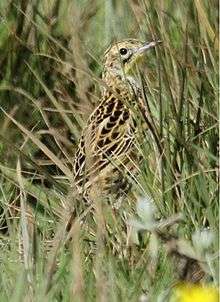Sharpe's longclaw
| Sharpe's longclaw | |
|---|---|
 | |
| Scientific classification | |
| Kingdom: | Animalia |
| Phylum: | Chordata |
| Class: | Aves |
| Order: | Passeriformes |
| Family: | Motacillidae |
| Genus: | Hemimacronyx |
| Species: | M. sharpei |
| Binomial name | |
| Hemimacronyx sharpei (Jackson, 1904) | |
| Synonyms | |
|
Macronyx sharpei | |
The Sharpe's longclaw (Hemimacronyx sharpei) is a passerine bird in the longclaw family Motacillidae, which also includes the pipits and wagtails. It is endemic to Kenya.
It is 16–17 cm long, with upperparts heavily marked with buff and rufous streaks, yellow underparts, and white outertail feathers in flight.
This bird is endangered, with an estimated population of less than 20,000. Its grassland habitat is being replaced by cultivation and woodlots.
The common name and Latin binomial name commemorate the British zoologist Richard Bowdler Sharpe.[2]
Taxonomy

The Sharpe's longclaw is a member of the family Motacillidae, which includes the pipits and wagtails. The species was originally placed with the other longclaws in the genus Macronyx, a treatment still followed by some taxonomists. Most now place the species with the yellow-breasted pipit in the separate genus Hemimacronyx. The two species are closely related and form a superspecies. This genus, along with the golden pipit in the genus Tmetothylacus and the longclaws form an exclusively African clade within the family, separate from the true pipits in the genus Anthus and the wagtails.[3]
Distribution and habitat
The Sharpe's longclaw is found in the highlands of west and central Kenya. It has a restricted distribution, occurring on the northern slopes of Mount Kenya, the southern slopes of the Aberdares, on the Gishu, Mau and Kinangop Plateaus around the Rift Valley, and the Kenyan slopes of Mount Elgon (possibly the Ugandan slopes as well).[3]
The natural habitat of the species is open treeless grassland with short and often tussocky grasses. It ranges between 1,850 and 3,400 m (6,070–11,150 ft) in altitude, although more commonly below 2,800 m (9,200 ft). It occurs at higher altitudes than the yellow-throated longclaw, with little overlap between the ranges of the two species. It is generally non-migratory, but will travel short distances when its habitat becomes too dry.[3]
Behaviour
Diet and feeding
The Sharpe's longclaw feeds on insects, particularly grasshoppers and beetles. Other invertebrates are taken as well. Within its range it has a higher feeding rate in grasslands with tussocks. The species forages alone or in pairs, sometimes in small family groups.[3]
Breeding
The Sharpe's longclaw is a monogamous and solitary breeder that defends a territory. The breeding season is during or after the rains, from March to June, September to October and in December. The species has a brief aerial breeding display, where the bird flies up and then drops, singing rapidly as it drops. The nest is a well-made cup of dried grass lined with roots and placed near the ground at the base of a grass tussock or under a shrub or plant. Between two and three eggs are laid.[3]
References
- ↑ BirdLife International (2012). "Macronyx sharpei". IUCN Red List of Threatened Species. Version 2012.1. International Union for Conservation of Nature. Retrieved 16 July 2012.
- ↑ Beolens, Bo; Watkins, Michael (2003). Whose Bird? Men and Women Commemorated in the Common Names of Birds. London: Christopher Helm. p. 309.
- 1 2 3 4 5 Tyler, Stephanie (2004). "Family Motacillidae (Pipits and Wagtails)". In del Hoyo, Josep; Elliott, Andrew; Christie, David. Handbook of the Birds of the World. Volume 9, Cotingas to Pipits and Wagtails. Barcelona: Lynx Edicions. pp. 689–743. ISBN 84-87334-69-5.
